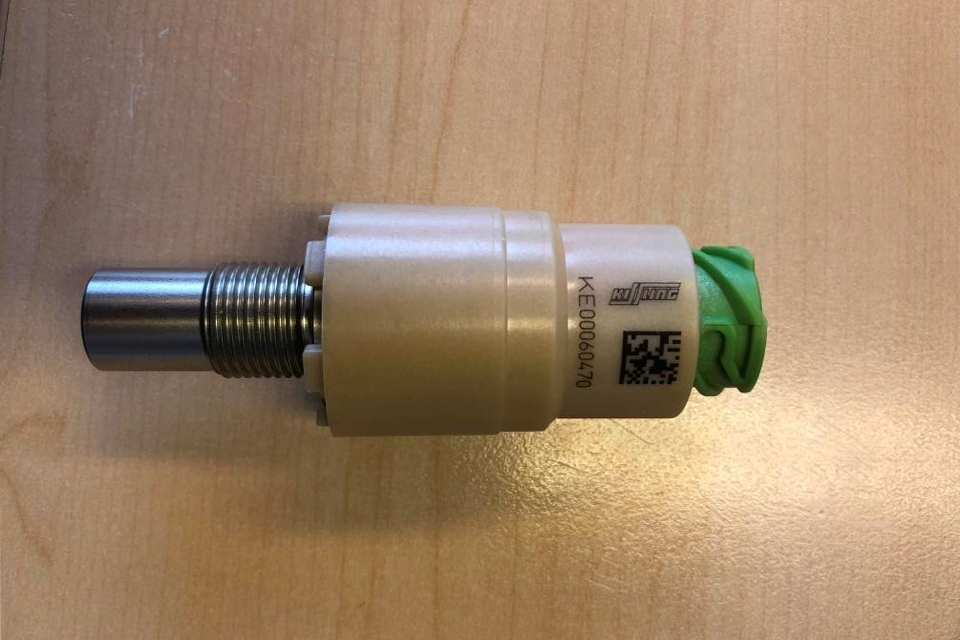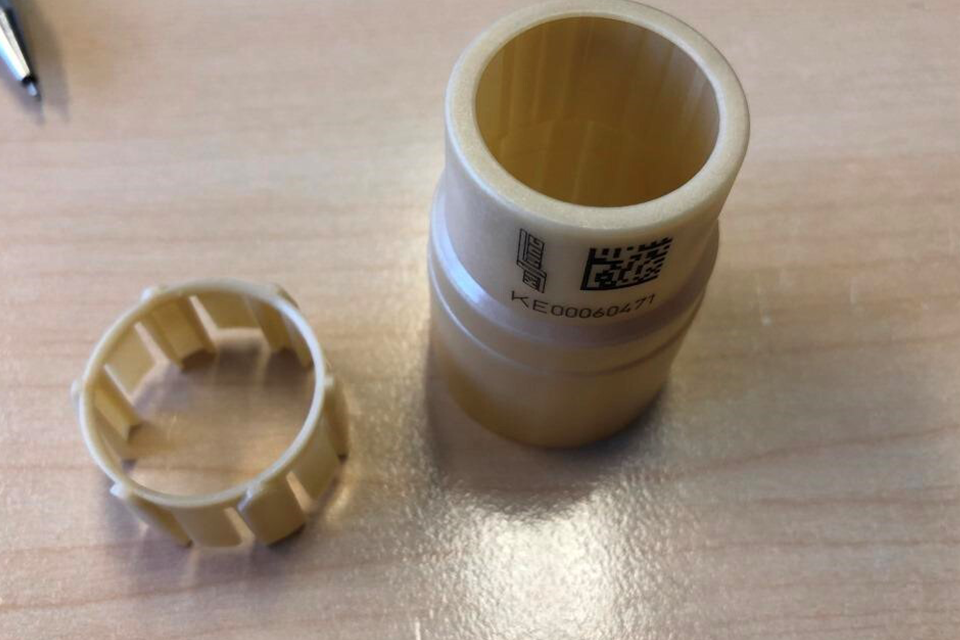Approved tachograph centre special notice 03-20
Published 2 July 2020
Applies to England, Scotland and Wales
1. Kissling Seals
The Driving and Vehicle Standards Agency (DVSA) is aware of a type of seal being used in Annex 1C tachographs. Following checks regarding its suitability, DVSA considers the seal does not meet the necessary criteria for use in GB. As a result this seal may not be used for any GB calibration, and if seen on a vehicle brought in for calibration, must be removed as part of the calibration process. DVSA will not take any action on vehicles with this seal fitted if they have not received a calibration in GB, however any such vehicles being calibrated at a centre must have these seals removed and replaced. If a GB calibration is undertaken and subsequent to this the seal is still present, DVSA may take enforcement action, including disciplinary action against the technician and centre.

A fitted Kissling seal

A Kissling seal

A Kissling seal disassembled
2. Stoneridge x35 error
DVSA is in receipt of a Service Information Letter (ref 19_016A) from Stoneridge which highlights that that some vehicles equipped with SE5000-8 Tachograph and Continental Kitas 4.0 motion sensor have intermittent x35 errors. x35 is one of the error codes in 1C tachographs relating to the motion sensor. The 3 events below are typical examples of events which could activate x35 intermittently when the vehicle is not driving:
a) Connection Tachograph/Sensor
Intermittent cable connection between tachograph and sensor. This error is not common and would likely also appear when the vehicle is driving.
b) Workshop Inspection
During system inspection at a workshop, the sensor cable is removed for inspection and test, therefore, power to the sensor is interrupted. This will cause the KITAS 4.0 to enter a “penalty state” for a fixed period of time. Consequently, following reconnection, the SE5000-8 will set the error code x35 active since the KITAS 4.0 does not answer to the communication request as expected. As soon as the KITAS 4.0 returns from the “penalty state”, at least 2min after reconnection, the communication is restored. Functionality and integrity of the system is not affected.
c) Recording equipment hibernation (sleep mode)
In rare occasions when the recording equipment is in hibernation, the SE5000-8 and KITAS 4.0 have been found to have communication issues. This causes a sensor penalty state and the SE5000-8 will set the error code x35 active when seeking to resume communication at ignition on.
Communication is restored and the error is deactivated but will remain in the SE5000-8 memory, this is seen on the technical printout as an x35 error with duration of 0h00min. Functionality and integrity of the system is not affected. To prevent the x35 event from occurring in the SE5000-8 the system hibernation in the tachograph should be disabled at the next periodic calibration. It is not necessary for the tachograph to be calibrated earlier than the normal two-year cycle. Please note that the SE5000-8 in combination with Lesikar motion sensor will not trigger the x35 error when the vehicle is not driving as per point b) and c) above. It is envisioned that these errors should be rectified at the next periodic calibration, and instructions on how this is achievable should be obtained from Stoneridge. DVSA staff have been instructed not to take enforcement action when the error is encountered and the above criteria is satisfied.
The following process has been agreed when using the Optimo system and VDO Workshop Tablet - the procedure is to be completed under minor work:
- Technician produces technical printout
- Disable sleep mode only using Optimo or VDO Workshop Tablet
- Produce 2nd technical printout checking NO calibration box 4 has been added
- Produce minor work paperwork, attach printout, and keep in records
3. Low speed measurements of L and W using rolling road equipment
DVSA has been made aware that workshops are conducting low speed calibrations of tachographs using equipment which has not been approved for low speed calibration work. For absolute clarity, under no circumstances must this occur unless the equipment (such as Roller Brake Conversions) has been specifically approved for this. Any centres found to be doing so will face disciplinary action and any calibration using this method will be declared null and void. The centre will then be expected to ensure the re-calibration can be undertaken correctly and at no cost to the operator. DVSA understands this may occur due to vehicle braking systems causing some issue with rolling road systems. These systems may be deactivated for the period of the calibration, and it is not acceptable to circumvent procedures for this reason. Any trainers found to be training technician staff to use this method when it is inappropriate may also face action.
4. 1C Tachograph sealing requirements
DVSA has also been made aware that some 1C tachographs have not been sealed correctly, in that the seal has not been embossed as required by the legislation. This is usually the gearbox seal. All 1C tachographs must include the use of sealing pliers on all relevant seals. Without this the calibration may attract the issue of fixed penalty notices if abroad. DVSA will not be enforcing any calibrations found without the correct embossing conducted prior to the issue of this notice. If any centres have been conducting such calibrations then contact must be made with the tachosection@DVSA.gov.uk to make DVSA aware.
If any calibrations are made following this notice without the correct embossing, then the calibration will be considered null and void, a prohibition notice may be issued, and any such vehicles must then be re-calibrated at no cost to the vehicle operator.
5. Quality control checks provided by training staff
Normally the quality control (QC) for a centre is the most experienced technician, with the minimum criteria being the QC is a Workshop card holder. They may be from a different centre (although no one under any circumstances may remove their Workshop card from the premises of their base centre), or work for a different company and operate an exchange. Additionally, companies who conduct approved tachograph training courses are also permitted to complete QC duties. Of the staff within those companies, only those who conduct the full initial training courses may complete QC duties. No other staff may do so, and DVSA will consider withdrawing the approval of any training organisation who does so. The current approved training providers are as follows:
Continental Automotive Trading UK Ltd
Continental Automotive Trading UK Ltd
36 Gravelly Industrial Park
Birmingham
B24 8TA
Telephone: 0121 3261200
Email: uk@vdo.com
Phoenix Equipment Ltd
Phoenix Equipment Ltd
Nobel Road
Wester Gourdie Industrial Estate
Dundee
DD2 4UH
Telephone: 01382 849230
Email: sales@phoenixequip.co.uk
Skillray Transport Services UK Ltd
Skillray Transport Services UK Ltd
10 Rufford Court
Hardwick Grange
Warrington,
WA1 4RF
Telephone: 01925 880081
Email: sales@skillray.co.uk
Encompass GRP Ltd
Encompass GRP Ltd
Silverstone Park
Silverstone
NN12 8GX
Telephone: 01327 317533
Email: contact@encompass-uk.com
No other companies or staff are qualified to do such work. As and when this list is updated a notice will be issued. As a reminder it should be noted that any QC, regardless of by whom they are employed, may face disciplinary action as per the Approved Tachograph Centre Manual (ATCM) if work conducted by the centre falls short of the standard required.
Distance learning re-certification training courses
The following companies now have approved distance learning re-certification courses:
Skillray Transport Services UK Ltd
Skillray Transport Services UK Ltd
10 Rufford Court
Hardwick Grange
Warrington
WA1 4RF
Telephone: 01925 880081
Email: sales@skillray.co.uk
Encompass GRP Ltd
Encompass GRP Ltd
Silverstone Park
Silverstone
NN12 8GX
Telephone: 01327 317533
Email: contact@encompass-uk.com
These use a varying mix of internet-based video sessions, remote instruction, and written examination. As other providers are approved, their details will be added in the next Special Notice.
